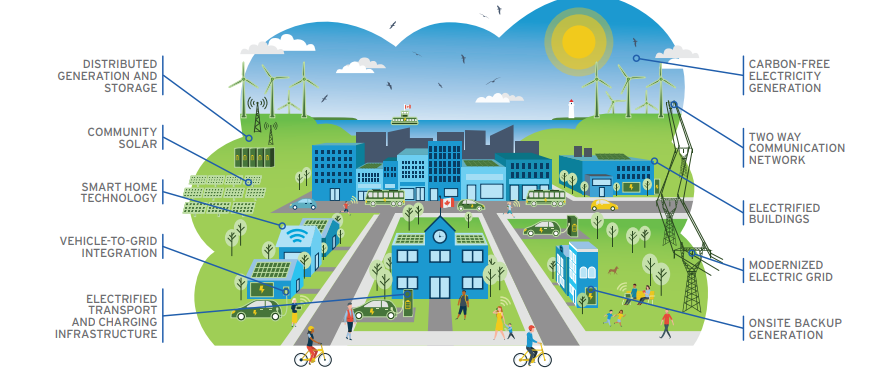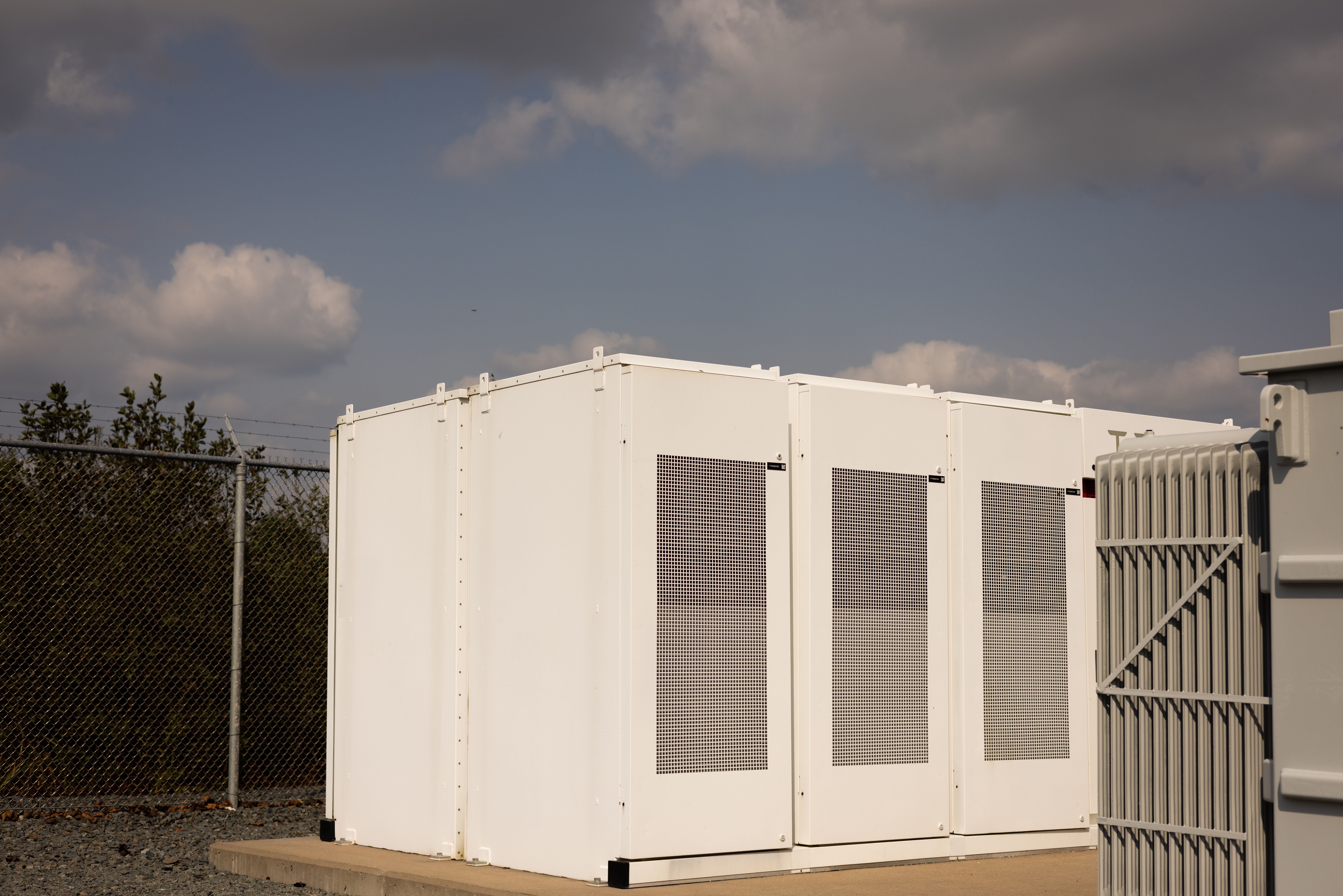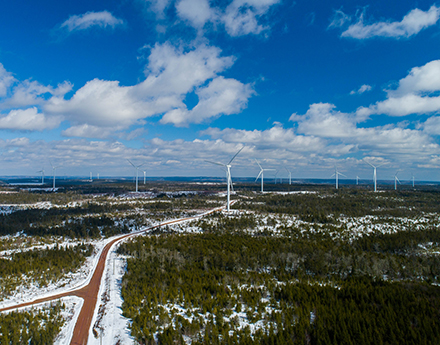A smarter, cleaner energy future
Adapted from the keynote speech at the Smart Energy Conference on April 25, 2022 by Mark Sidebottom, Chief Operating Officer.
Imagine Nova Scotia’s energy future.
It’s a future where battery technology, solar and wind systems, smart meters and a smarter grid work together to provide green energy options.
It’s a future where customers can save money by better understanding their energy use—because that data is at their fingertips.
It’s a future where new jobs are created in Nova Scotia and across the region. From the technical skills and expertise for the construction of new energy infrastructure, to the opportunities to provide new products and services—installing and maintaining EV chargers, modifying homes with smarter technology—these are green jobs for the green economy.
This isn’t a future that’s far off. We’re not just imagining these benefits—we’re seeing them in action today. It’s all driven by collaboration with our customers, as well as industry partners, government, First Nations, communities and stakeholders.
The Path to 2030
Over the past few years, the clean energy transition has taken on a number of different names and acronyms in our part of the country: ECEI, Eastern Clean Energy Initiative, Atlantic Loop, Clean Energy Road Map. Here in Nova Scotia, we have eight coal units to retire before 2030 to achieve our legislated target of 80 per cent renewable. So, for us it’s about The Path to 2030.
The Path to 2030 will require a portfolio of energy solutions. One of those solutions is the Atlantic Loop—a new transmission line, connecting Nova Scotia and New Brunswick to clean energy sources in other parts of Canada. The Atlantic Loop is one piece of the puzzle and will be a great energizer for jobs in the region, including construction, engineering, power line technicians, planners and everything in between.
The Province of Nova Scotia has been working to advance discussions and secure funding for this important solution for our region. Including work with the federal government, neighbouring utilities and other provincial governments to develop and launch the Atlantic Clean Power Roadmap earlier this year, which outlines the concept of the Atlantic Loop. We’re committed to supporting these efforts and confident that the Atlantic Loop will help achieve Canada’s and Nova Scotia’s ambitious 2030 climate goals.
But the future of energy in Nova Scotia must include more than imported energy, and this is proven time and time again in our Integrated Resource Planning models.
We also need to continue strengthening, modernizing and improving our system as more renewable energy is brought onto the grid. This becomes increasingly urgent when you think of the challenges from severe weather and climate change. This impacts our infrastructure and is especially top of mind for us after experiencing eight major winter storms during the first two months of this year, which represents more than what we experienced in the last two years combined.

The electricity grid of the future
As we move forward on our Path to 2030, we need a mix of solutions to ensure we can continue to provide reliable electricity, exactly when our customers need it, every day.
We’re focusing our work in the areas of wind, battery storage and the conversion of coal units to natural gas fired units.
Wind
We’re lucky to have an abundance of wind here in Nova Scotia, and we’re building a team to bring more wind production onto the system, in addition to the open request from government for 350 MW of wind from independent producers.
We’ve identified prime locations in the province for potential wind installations and our approach will be similar to past wind project collaborations, including Sable Wind and South Canoe. In both cases, thanks to great collaboration with government, business and community partners, the resulting projects incorporated feedback and input from customers and stakeholders as well as engagement with the local community.
It’s clear that when we work together—as an industry and a community—the result is a more reliable system, an engaged community and the most affordable approach for customers. We want to do more of the same.
Batteries
Despite the wind’s very best efforts in our province, as we know, wind cannot reliably match demand for electricity. We need a backup source of energy and that’s where batteries come in.
We’ve established a team to work on incorporating grid-scale battery solutions to store that renewable energy and balance the grid, ensuring continued reliable service for our customers.
As an example, as part of the Smart Grid Pilot Project to test how to most effectively incorporate batteries on the system, the 1.2-MW battery we installed at our substation in Elmsdale enables us to store power generated at the nearby wind farm and then supply that electricity to the grid to match customer demand.
Our battery team is currently exploring the best and most cost-effective options for much larger, grid-scale batteries. It’s early days in this work, but we expect to be able to share details this year and engage with stakeholders on everything from locations, design and concept to opportunities for communities to be aware and involved in the process.
Coal to natural gas
We also have a team working on the conversion of two of our coal units to natural gas, while ensuring we’re planning for the future and the potentially eventual use of hydrogen for these units.
The potential for hydrogen is incredible. Not just for utilities, but many other applications, including buildings and transportation. Hydrogen can be produced from diverse local resources with the potential for near-zero greenhouse gas emissions. Once produced, it generates electrical power in a fuel cell, emitting only water vapor and warm air.
It’s something we’re watching closely, because we need to ensure we’re exploring all options and planning for the future. This includes blue hydrogen, carbon capture and storage technology. We’re also watching the development of Small Modular Reactors. It’s all about balancing priorities, cutting carbon and exploring new technology, while keeping electricity affordable and reliable for our customers.
Working together
Nova Scotia has the potential to be one of the cleanest, lowest-carbon, most resilient regions in Canada— if we work together. No one player in our energy system can do it alone. The important changes in our province, that we have collectively made so far, took effort and coordination by all of us: government, customers, industry and the private sector. Together, we are laying the groundwork for transformative change and a greener Nova Scotia. The momentum is building because we're all rowing in the same direction.
A thriving, green economy is a future we can all be proud of and one we’re striving for. It’s a future where we can drive to work in a car powered by net-zero energy, not feeling guilty about the environmental impacts to future generations. It’s a safer, more interconnected future where if we forget to turn off the stove or lock our doors, we can safely do so from our device. It’s a more affordable future, where we have more insight and control of the power use in our homes, in real time, and can find and address small issues before they become bigger problems.
It’s an exciting time. The future is happening now, and if we continue to work together, we can secure it.
For more information about Nova Scotia’s clean energy transition, visit our Clean & Green page.
Share This Post:






